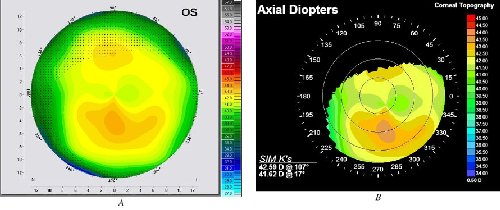Repeatability of corneal first-surface wavefront aberrations measured with Pentacam corneal topography
PURPOSE: To assess the repeatability of corneal wavefront aberrations derived from Pentacam (Oculus) corneal topography.
METHODS: Forty-five normal participants and 10 participants with keratoconus were tested. Intraobserver and interobserver repeatability was determined using 4 observers within and between sessions. Topographical maps were exported to external software, and corneal first-surface wavefront aberrations were calculated using a 10th-order Zernike expansion over a 6.0 mm optical zone. Repeatability was determined with Bland-Altman limits of agreement and expressed as the coefficient of repeatability (COR).
RESULTS: Initial data showed high wavefront aberrations in normal participants and poor repeatability. Topographical maps showed extrapolated topography in zones without data acquisition; maps with less than 6.0 mm of complete data were excluded in the final analysis. The mean wavefront aberrations for normal participants remained high, but repeatability improved. The COR relative to the magnitude of wavefront aberrations was high (average 100%) across all modal pairs and orders, although best for total higher-order root mean square. Participants with keratoconus had higher magnitude wavefront aberrations and poorer repeatability but similar COR to average wavefront aberration ratios. Examination of raw elevation data showed poor repeatability.

Figure 2. A: Topographic map generated by the Pentacam showing data out to 12.0 mm. B: Topographic map generated by VOLPro for the same patient showing incomplete data with the central 6.0 mm (rings are 3.0 mm, 6.0 mm, and 9.0 mm in diameter).
CONCLUSIONS: Wavefront aberrations calculated from Pentacam corneal topography were large in magnitude, and reliability was poor, largely due to variability in corneal elevation data. Intraobserver and interobserver reliability within and between sessions was comparable. The Pentacam was not reliable in measuring corneal wavefront aberrations.
J Cataract Refract Surg 2008; 34:727–734 Q 2008 ASCRS and ESCRS
Accepted for publication November 28, 2007.
Hema Shankar, BMBS, MA,
Deepa Taranath, MBBS, MS(Ophthal),
Chandramalar T. Santhirathelagan, MBBS, MMED(Ophthal),
Konrad Pesudovs, PhD
Flinders Eye Centre, Flinders Medical Centre, Bedford Park, South Australia, Australi

Repeatability of Wavefront Aberrations Measured with Pentacam as PDF (680 Kb)
![]()
Index of Papers
[ Welcome ][ Publications ]

